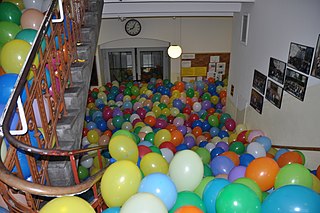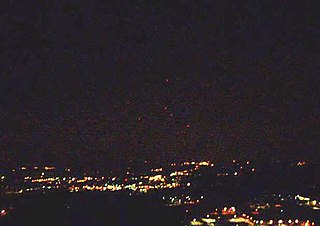Related Research Articles

A hoax is a widely publicised falsehood created to deceive its audience with false and often astonishing information, with the either malicious or humorous intent of causing shock and interest in as many people as possible.

The University of Otago is a public research collegiate university based in Dunedin, Otago, New Zealand. Founded in 1869, Otago is New Zealand's oldest university and one of the oldest universities in Oceania.
Hugh Charles Troy, Jr. (1906–1964) was a US painter who is noted for his pranks.

Drake's Plate of Brass is a forgery that purports to be the brass plaque that Francis Drake posted while anchored in Drake's Bay in Northern California in 1579. The hoax was successful for 40 years, despite early doubts. After the plate came to public attention in 1936, historians raised questions regarding the plate's wording, spelling, and manufacture. The hoax's perpetrators attempted to apprise the plate's finders as to its origins. Many presumed the plate to be authentic after an early metallurgical study concluded it was genuine. In the late 1970s, scientists determined that the plate was a modern creation after it failed a battery of physical and chemical tests. Much of the mystery surrounding the plate continued until 2003, when historians advanced a theory about who created the plate and why, showing the plate to be a practical joke by local historians gone awry. The plate was acquired by and is often on display at the Bancroft Library of the University of California, Berkeley.

A senior prank, also known as muck-up day in Australia and the United Kingdom, is a type of organized prank by the senior class of a school, college, or university. They are often carried out at or near the end of the academic year and are part of school traditions. While most senior pranks are harmless, more severe pranks can include damage to school property and other crimes, which can result in disciplinary or even legal repercussions against the perpetrators.
Capping Week is a term used in New Zealand for the week of graduation from university. This is when graduands of the university are presented with their degrees and capped. Capping week may coincide with a period of practical jokes or capping stunts.
The Lonnie Zamora incident was an alleged UFO sighting that occurred on April 24, 1964 near Socorro, New Mexico when Socorro police officer Lonnie Zamora claimed he saw two people beside a shiny object that later rose into the air accompanied by a roaring blue and orange flame. Zamora's claims were subject to attention from news media, UFO investigators and UFO organizations, and the U.S. Air Force's Project Blue Book listed the case as "unknown". Conventional explanations of Zamora's claims include a lunar lander test by White Sands Missile Range and a hoax by New Mexico Tech students.

A practical joke or prank is a trick played on people, generally causing the victim to experience embarrassment, perplexity, confusion, or discomfort. The perpetrator of a practical joke is called a "practical joker" or "prankster". Other terms for practical jokes include gag, rib, jape, or shenanigan. Some countries in western nations make it tradition to carry out pranks on April Fools' Day and Mischief Night.

The Great Rose Bowl Hoax was a prank at the 1961 Rose Bowl, an annual American college football bowl game. That year, the Washington Huskies were pitted against the Minnesota Golden Gophers. At halftime, the Huskies led 17–0, and their cheerleaders took the field to lead the spectators in the stands in a card stunt, a routine involving flip-cards depicting various images for the audience to raise. However, a number of students from the California Institute of Technology managed to alter the card stunt shown during the halftime break, by making the Washington fans inadvertently spell out CALTECH.

At the annual Harvard–Yale football game on November 20, 2004, Yale students, costumed as a Harvard "pep squad", distributed placards to Harvard fans for a card stunt. When the fans raised the placards together, they read "We Suck".

Barsa-Kelmes was a former island, the largest in the Aral Sea. Its area was 133 km2 in the 1980s, but as the sea became more shallow it steadily grew, until in the 1990s it ceased to be an island. Its highest altitude was 113 m.

April Fools' Day or All Fools' Day is an annual custom on 1 April consisting of practical jokes and hoaxes. Jokesters often expose their actions by shouting "April Fools!" at the recipient. Mass media can be involved with these pranks, which may be revealed as such the following day. The custom of setting aside a day for playing harmless pranks upon one's neighbour has been relatively common in the world historically.
The 1956 Olympic flame hoax was an incident in which Barry Larkin, a veterinary student at the University of Sydney, ran with a homemade torch and fooled spectators, including a police escort and the Lord Mayor of Sydney, into thinking he was the torchbearer of the Olympic flame. The Independent called it the greatest hoax in Olympic history.
A media prank is a type of media event, perpetrated by staged speeches, activities, or press releases, designed to trick legitimate journalists into publishing erroneous or misleading articles. The term may also refer to such stories if planted by fake journalists, as well as the false story thereby published. A media prank is a form of culture jamming generally done as performance art or a practical joke for purposes of a humorous critique of mass media.

The 2009 Morristown UFO hoax was a series of aerial events involving mysterious floating red lights in the sky, that first occurred near Morristown, New Jersey, on Monday, January 5, 2009, between 8:15 pm and 9:00 pm. The red lights were later observed on four other nights: January 26, January 29, February 7, and February 17, 2009. The events were later revealed to be a hoax, perpetrated by Joe Rudy and Chris Russo. Rudy and Russo have described the hoax as a social experiment, with the ambition of exposing "ufology" as a pseudoscience and raising consciousness around unreliability of eyewitness claims.
A prank call is a telephone call intended by the caller as a practical joke played on the person answering. It is often a type of nuisance call. It can be illegal under certain circumstances.
The 2009 Latvian meteorite hoax was a publicity stunt in which Swedish-based telecommunications company Tele2 staged an apparent meteorite landing which was later revealed to be fake.
The college rivalry between the California Institute of Technology (Caltech) and the Massachusetts Institute of Technology (MIT) stems from the colleges' reputations as the top science and engineering schools in the United States. The rivalry is unusual given the geographic distance between the schools, one being in Pasadena, California, and the other in Cambridge, Massachusetts, as well as its focus on elaborate pranks rather than sporting events.
References
- ↑ Farrar, David (21 October 2006). "Student pranks". Kiwiblog.
- ↑ "UFOs and aliens Archived 28 April 2006 at the Wayback Machine ". skeptics.org.nz.
- ↑ "King Kong comes to Massey!!!". Chaff Vol 70, Issue 11, 17 May 2004, p. 7
- ↑ "Virus release a capping stunt?" (from the nzcity.co.nz website, 11 May 2005)
- ↑ "Foot and mouth scare". The Dominion Post , 12 May 2005, p. 5